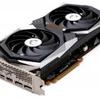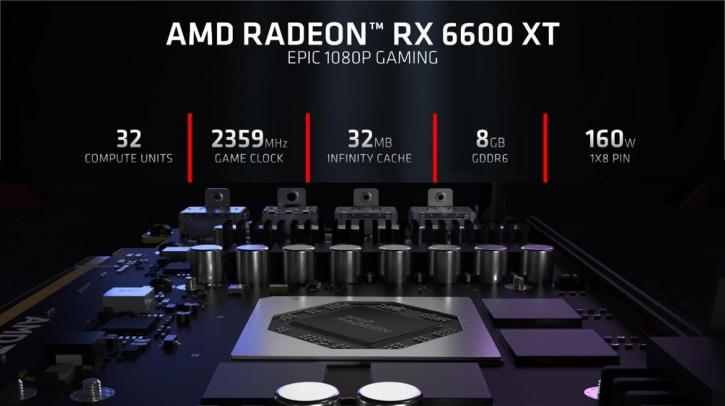GPU Architecture and specs
GPU architecture and spcifications
With the release of the Radeon 6600 XT, AMD now has the mainstream spectrum of their cards filled. We can label the card as being mainstream to high-end, however with an enthusiast price, unfortunately. The card breathes through its RDNA2 architecture, the GPU empowering it is the NAVI23 (XL).
The transistor count for this product series again is on the high-side, and that has everything to do for the real estate marketed as infinity cache, as well as additional Raytracing cores. Where 'Big Navi' as a GPU holds 80 CUs (Compute units); Navi 23 holds 32 of them. Each CU holds 64 shading/stream processors. When multiplied you'll end up at 32x64= 2048 shader cores. Each CU has 1 RT (Raytracing) core tied to it, which means 80 cores for the 6900XT, 72 for the 6800 XT, 60 for the 6800, 40 for the Radeon RX 6700 XT and thus 32 for the 6600 XT. Historically AMD has had 4 texture units per CU, so that's 320 units for the 6900 XT, 288 for 6800 XT, 240 units for the 6800, 160 for the Radeon 6700 XT, and 128 for the 6600 XT. The ROP count is 128 units for 6800 XT and 6900 XT, 96 for the 6800, 64 for the Radeon RX 6700 XT, and 32 for the 6600 XT.
Infinity Cache gets downsized to 32MB
One change seen from AMD's previous GPU architecture is Infinity Cache. AMD's RDNA2 GPUS has a strong need for memory bandwidth, the 256-bit bus for the 6800/6900 series was already marginal. With the 6700 XT at 192-bit wide, this product is downright bandwidth limited. GDDR6 memory is a cheaper approach than what NVIDIA is doing with GDDRX and helps them cut costs. However, to tackle the issue, they needed to add a rather expensive L3 cache on the GPU, to divert the bigger part of that challenge. Adding a relatively big chunk of cache memory will take the load off the memory bus. and that helps tremendously in performance per watt really, but also greatly helps raytracing. So very simply put, IC is cache memory, and that cache memory is placed directly into the chip itself (on-die). Normally a GPU has a few megabytes of cache memory (L1 and L2). Then there's a huge gap in between the many gigabytes of VRAM that the frame buffer has. This gap is bridged with Infinity Cache. Arbitrarily speaking you could look at IC as an L3 cache that is more capable to provide the GPU with sufficient and faster data in a faster manner and reduces frame buffer utilization. For the 6800/6900 series, AMD injected 128MB Infinity Cache used in combination with a 256-bit memory bus. The Radeon RX 6700 XT with its limited 192-bit wide memory bus gets 96MB of L3 cache and the 6600 XT drops that further towards 32 MB. In our findings, this bigger 'L3' cache helps out greatly in the lower resolutions and fillrate limited render cases, it, however, is not a complete solution as the high you go in resolution, the faster performance will drop.
Smart Access Memory
AMD's Smart Memory Access gives Ryzen 3000/5000 series processors full access to GPU memory if you have a compatible processor and B550 or X570 chipset AND an RNDA 2-powered Radeon RX 6000 series graphics card that is. Normally you are limited to a block of 256MB max. Smart Access Memory thus efficient use of the combined memory of the CPU and GPU, reducing buffering and latency - great news for gamers and it utilizes the PCI-express bus. In our experience some games can benefit a few percent, others 5%, some 10%, and also a lot simply do not benefit from this. SAM requires that CSM Support is turned off in the BIOS in order to enable the above 4G decode function, which will allow Resizable Bar Support (SAM) to be enabled. One problem here is that if your Windows installation is configured as non-UEFI, Windows will be unable to boot. In order to test it, you would need to reinstall Windows with CSM support disabled. Please understand that mandatory is a Series 500 chipset-based motherboard, a Ryzen Series 3000/5000 processor, and RX 6000 Series graphics card.
Raytracing
With raytracing, you basically are mimicking the behavior, looks, and feel of a real-life environment in a computer-generated 3D scene. Wood looks like wood, however, the leaking resin will shine and refract its environment and lighting accurately. Glass and waves of water get refracted as glass based on the surroundings and lights/rays. Can true 100% raytracing be applied in games? Short term answer, no, partially. As you have just read and hopefully remembered, Microsoft has released an extension to DirectX; DirectX Raytracing (DXR). AMD now has dedicated hardware built into their GPUs to accelerate certain raytracing features. You have seen these in current games mostly as Shadow optimization, but most commonly used are reflections (water, puddles, windows, tiles, and so on). Rasterization has been the default renderer for a long time and you can add to that a layer of raytracing. Combining rasterization and raytracing we like to call Hybrid raytracing. and offers the best of both worlds. But make no mistake, the RT cores inside Big Navi can do full scene raytracing, however, would never be fast enough for real-time rendering.
| Radeon RX 6000 vs GeForce RTX 30 | ||
|---|---|---|
| Graphics card | Ray Tracing Cores | Tensor Cores |
| Radeon RX 6900 XT | 80 | NA |
| Radeon RX 6800 XT | 72 | NA |
| Radeon RX 6700 XT | 40 | NA |
| Radeon RX 600 XT | 32 | NA |
| GeForce RTX 3090 | 82 | 328 |
| GeForce RTX 3080 | 68 | 272 |
| GeForce RTX 3070 | 46 | 184 |
High clock speeds
RDNA2 architecture on that same 7nm node seems susceptible to increase clock frequencies. RX 5700 XT sits around 1950MHz, the boost speed of the reference Radeon RX 6600 XT reaches a close to 2600 MHz though the game clock is listed at 2359 MHz (=very high).
PCI Express Gen 4.0
Series RX 6000 support for PCI-express 4.0. Competitor AMD had been making big bets with the original NAVI products and already moved to PCIe Gen 4.0 as well as their chipsets and processors. But what does PCIe Gen 4.0 bring to the table? Well, simply put, more bandwidth for data to pass through.
|
PCIe Gen |
Line Code |
Transfer Rate |
x1 Bandwidth |
x4 |
x8 |
x16 |
|
1.0 |
8b/10b |
2.5 GT/s |
250 MB/s |
1 GB/s |
2 GB/s |
4 GB/s |
|
2.0 |
8b/10b |
5 GT/s |
500 MB/s |
2 GB/s |
4 GB/s |
8 GB/s |
|
3.0 |
128b/130b |
8 GT/s |
1 GB/s |
4 GB/s |
8 GB/s |
16 GB/s |
|
4.0 |
128b/130b |
16 GT/s |
2 GB/s |
8 GB/s |
16 GB/s |
32 GB/s |
|
5.0 |
128b/130b |
32 GT/s |
4 GB/s |
16 GB/s |
32 GB/s |
64 GB/s |
On the 4.0 interface, you’ll be hard-pressed to run out of bandwidth as each lane gets doubled up in that bandwidth, per lane. Of course, there has been a recent PCI-Express Gen 5.0 announcement as well, for ease of mind I already inserted it into the table.


